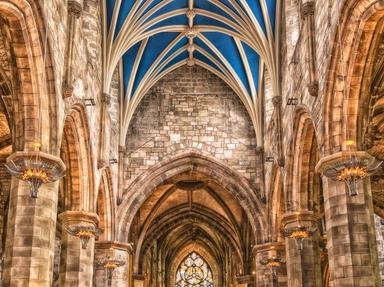Quiz Answer Key and Fun Facts
1. A suitable beginning would be this site that some people have claimed to be the world's first Christian church. Located in Antakya, Turkey (formerly Antioch), this church has been named for the Apostle who is believed to have preached there in the first century A.D. Ask him for the key if you wish to enter.
2. The Ukrainian capital of Kiev is home to this church whose onion shaped cupolas, a common feature of Russian churches, contribute to its visual appeal. Its name is similar to that of another church-cum-mosque that was built in Constantinople by the Roman Emperor Justinian in the sixth century. What is the name of this Ukrainian cathedral?
3. The African town of Lalibela, if not for anything else, is known for the eleven monolithic churches that were created there between the twelfth and thirteenth centuries. Located in a country that also claims to possess the Ark of the Covenant, what are these churches known as and where would they be found?
4. Paraportiani Church is located on the Greek island of Mykonos and has sometimes been referred to as a wedding cake. This is mostly due to the external walls of the church being covered in what, a common sight on the Greek Islands?
5. To merely look at St. James' Church in King Street, Sydney, one would not find anything particularly unusual about its appearance. However, upon learning the identity of the architect responsible for the design of this church, they might be surprised. Who designed St. James' Church, Sydney?
6. If you are up for it, a visit below the Church of All Saints in the Czech Republic will lead you to the underground chapel known as Sedlec Ossuary. Some unusual features that are contained within here have led to it being known as what?
7. To say that Spain's Sagrada Familia is unusual might be considered an understatement. Located in Barcelona, the unique latticed, carved and sculpted stone of this church is the trademark style of which Spaniard who dedicated much of the last years of his life to the building?
8. Visitors to Ruzica Church in the Serbian capital of Belgrade might be taken aback when first seeing the chandeliers that hang from the ceiling within. These examples of trench art are a by-product of a former use for this church and are mostly made of what?
9. Take a ferry across the Mersey and visit the oddly shaped Metropolitan Cathedral Church of Christ the King. In which English city would you need to be to see this 'fab' church?
10. Located in the Icelandic capital of Reykjavik, the Hallgrimskirkja Church is built entirely from concrete in a style that is said to symbolise which environmental feature that is a common sight on this island nation?
Source: Author
Aussiedrongo
This quiz was reviewed by FunTrivia editor
stedman before going online.
Any errors found in FunTrivia content are routinely corrected through our feedback system.

